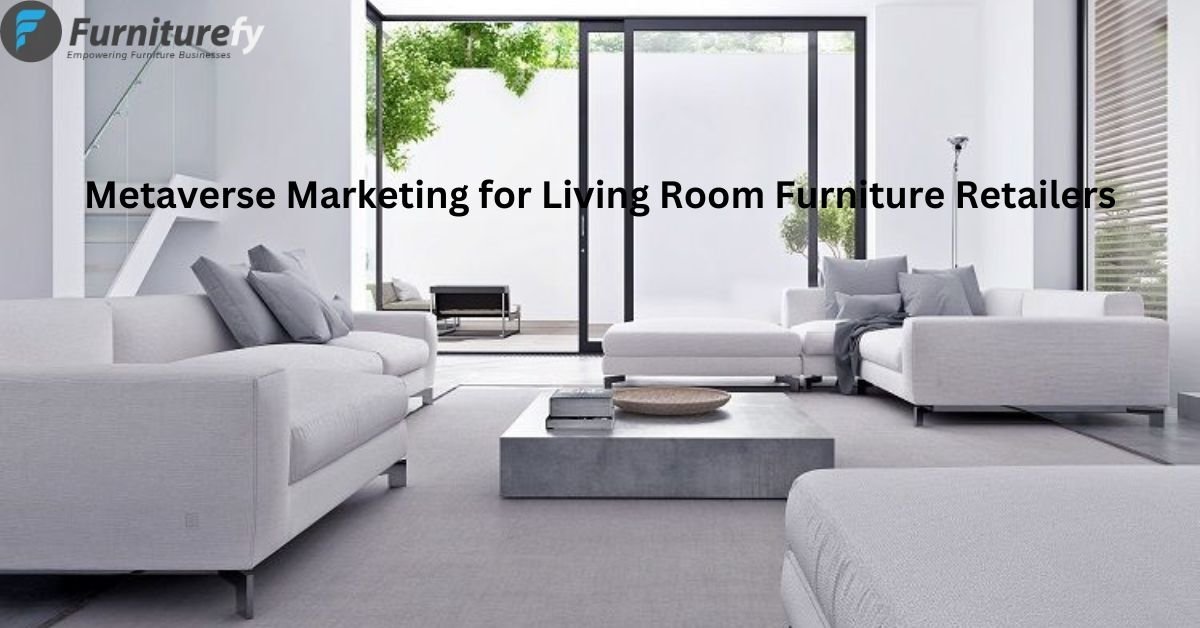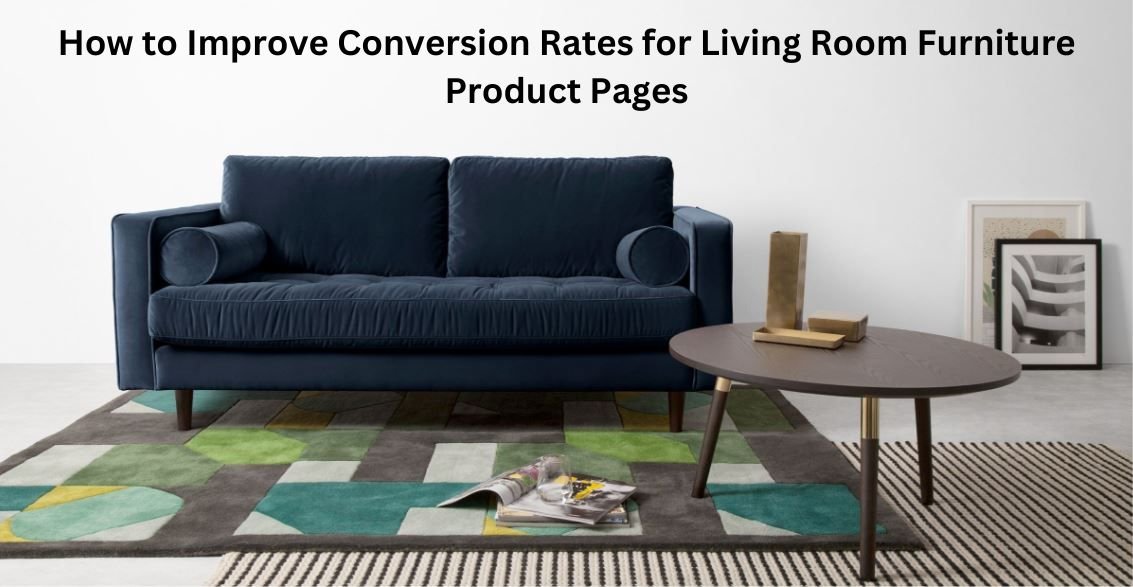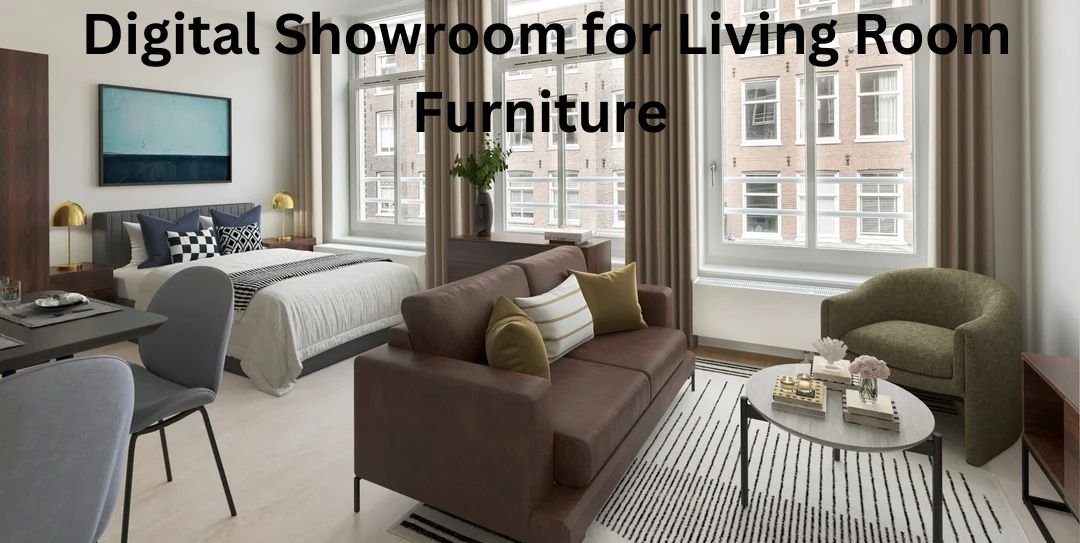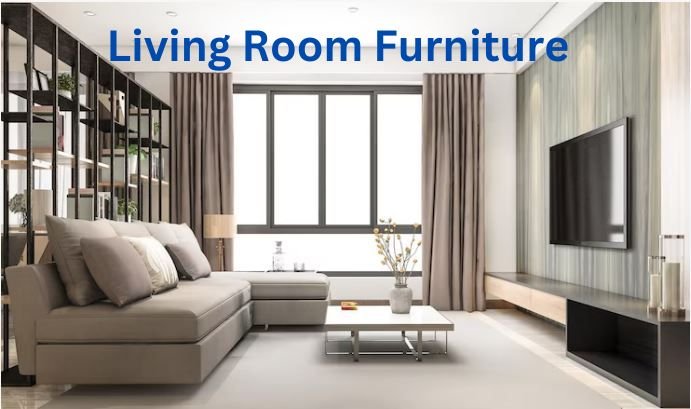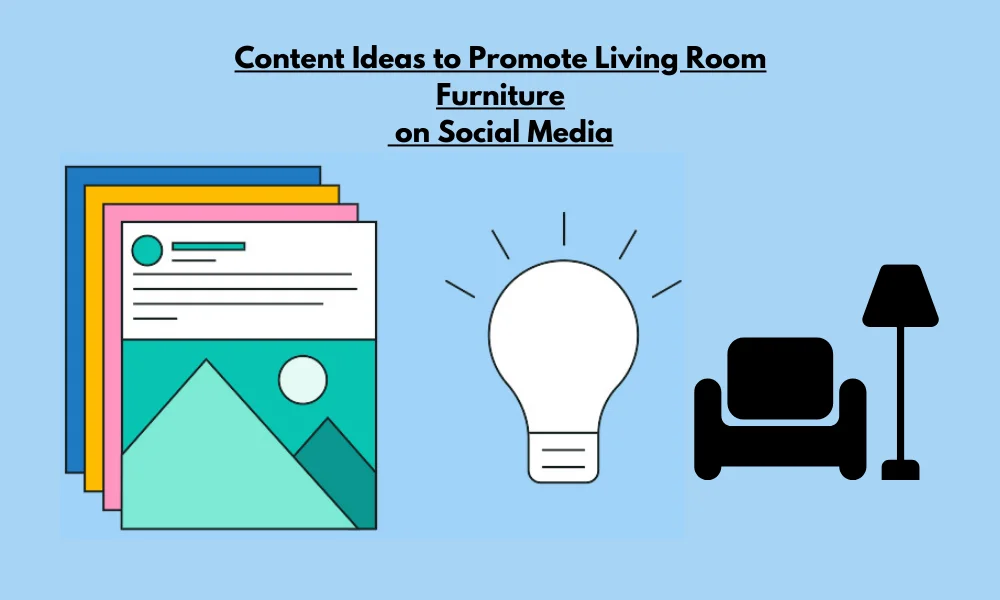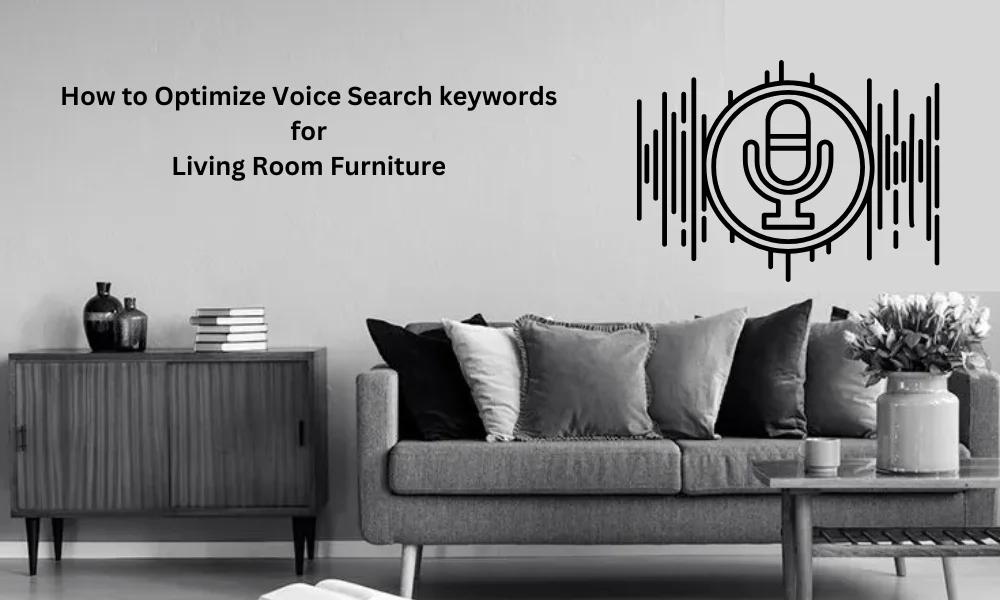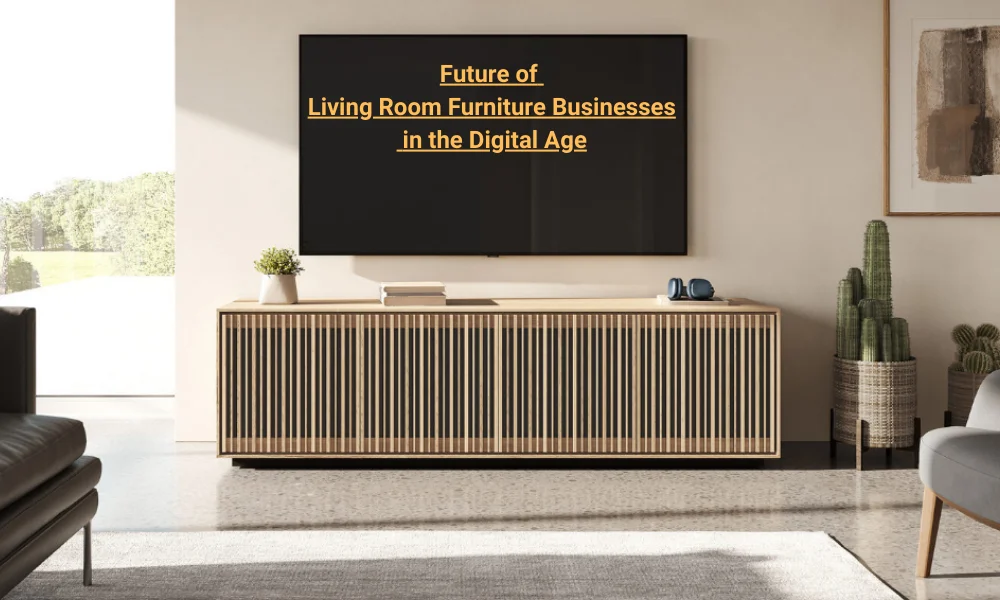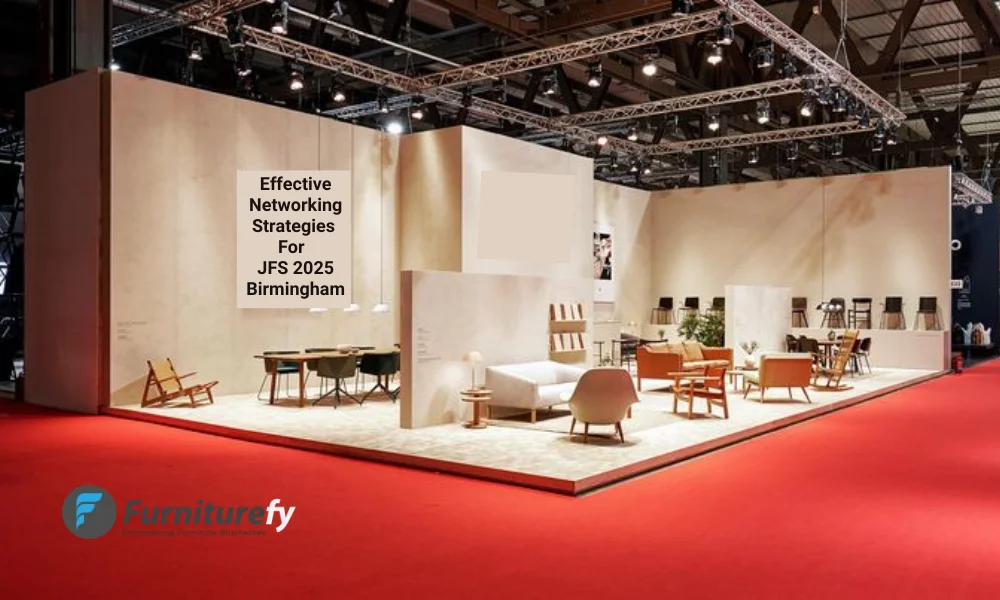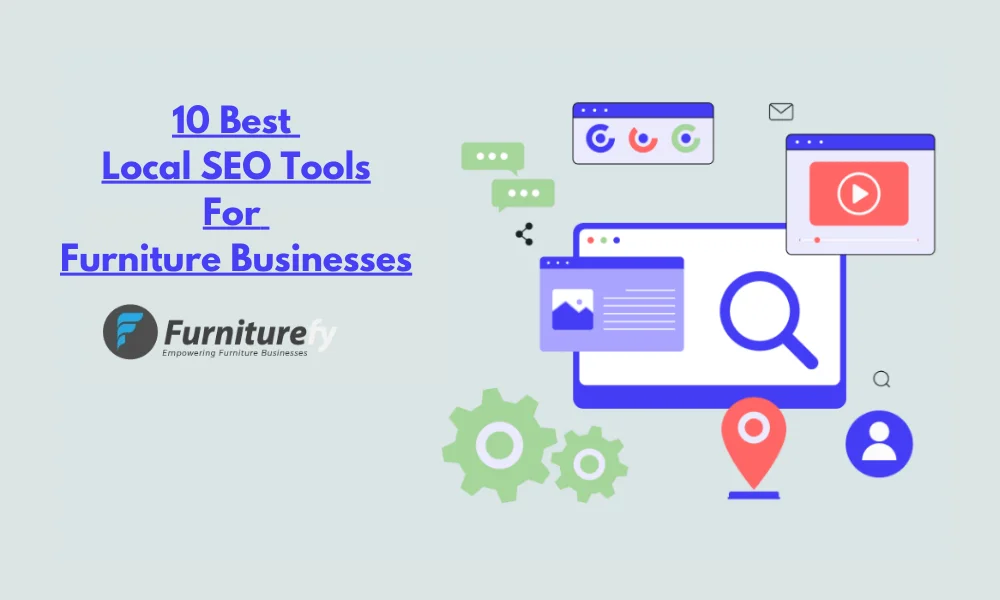Why Metaverse Marketing for Living Room Furniture Retailers is a must
The retail landscape is undergoing a revolutionary change, with the Metaverse emerging as a game-changer for businesses worldwide. For living room furniture retailers, this virtual realm offers a perfect opportunity to create attractive shopping experiences, enhance customer engagement, and boost sales. But why is Metaverse marketing essential for this sector?
Let’s dive in to understand its transformative potential.
What is the Metaverse?
The Metaverse is a 3D virtual world where users can interact in real time, using avatars to explore, shop, and socialize. This digital space blends augmented reality (AR), virtual reality (VR), and blockchain technology, offering endless possibilities for businesses to connect with tech-savvy consumers.
Why the Metaverse Matters for Furniture Retailers
1. Immersive Product Visualization
- Enhanced Shopping Experience: Customers can view furniture pieces in 3D, rotate them, and see how they fit into virtual living spaces.
- Personalized Design: Tools in the Metaverse allow users to customize furniture colors, sizes, and materials to match their preferences.
- Reduced Returns: With a clear view of what they’re buying, customers make more informed decisions, reducing the likelihood of returns.
2. Expanding Customer Reach
- Global Accessibility: The Metaverse eliminates geographical barriers, allowing retailers to reach a global audience.
- Attracting Younger Audiences: Millennials and Gen Z are early adopters of the Metaverse, making it easier to target this tech-savvy demographic.
- Increased Engagement: Interactive features like virtual showrooms and live chats with experts keep customers engaged longer.
3. Enhanced Brand Awareness
- Interactive Branding: Create branded virtual spaces that leave a lasting impression on customers.
- Collaborations and Events: Host virtual events, workshops, or collaborations with influencers to draw more attention to your brand.
- Gamification: Use games and challenges within the Metaverse to make your brand memorable.
4. Data-Driven Insights
- Customer Behavior Analysis: Track user interactions to understand customer preferences and improve offerings.
- Personalized Marketing: Use collected data to create targeted campaigns tailored to individual customers.
- Predictive Analytics: Leverage AI to forecast trends and customer needs, staying ahead of competitors.
5. Cost-Effective Marketing
- Lower Overheads: Virtual stores require less investment compared to physical showrooms.
- Scalable Campaigns: Launch marketing campaigns in the Metaverse that can scale with minimal additional costs.
- Streamlined Operations: Automate certain tasks, like customer support and product demos, reducing labor costs.
How Living Room Furniture Retailers Can Leverage the Metaverse
1. Build Virtual Showrooms
Allow customers to walk through realistic, interactive virtual spaces where they can view furniture collections, mix and match items, and purchase products seamlessly.
2. Offer AR/VR Integration
Enable customers to use AR apps to visualize furniture in their real homes or VR headsets to explore immersive furniture setups.
3. Introduce Virtual Consultation Services
Provide personalized design consultations through avatars or AI-driven assistants, enhancing the customer journey.
4. Gamify the Experience
Incorporate games, like room design challenges, where customers can win discounts or rewards for participating.
5. Collaborate with Influencers
Partner with digital influencers in the Metaverse to showcase your furniture collections in their virtual spaces.
Overcoming Challenges in Metaverse Marketing
1. High Initial Investment
While the Metaverse offers long-term benefits, setting up a virtual store or integrating AR/VR tools requires upfront investment. Retailers should start with basic features and gradually scale.
2. Technical Expertise
Navigating the Metaverse can be complex. Partnering with tech experts or hiring specialized teams can ease the process.
3. Ensuring Accessibility
Ensure that your Metaverse offerings are accessible across devices, from high-end VR headsets to smartphones, to maximize reach.
4. Privacy Concerns
Be transparent about data collection and implement robust security measures to build customer trust.
The Future of Metaverse Marketing for Furniture Retailers
The Metaverse is not just a trend; it’s the future of digital marketing. As technology advances, the possibilities for creating richer, more engaging customer experiences will expand. Furniture retailers who embrace this change now will position themselves as industry leaders.
Read more: Boost Online Visibility for cheap Furniture Stores in Birmingham, UK
Conclusion
For living room furniture retailers, the Metaverse is a golden opportunity to revolutionize their marketing strategies. By creating immersive experiences, reaching global audiences, and leveraging data-driven insights, brands can not only boost sales but also build lasting relationships with their customers. The time to enter the Metaverse is now. Are you ready to transform your business?
FAQs
Metaverse marketing involves promoting products and services in virtual 3D spaces using AR, VR, and blockchain technologies.
Retailers can offer immersive shopping experiences, expand their reach, and reduce costs through virtual showrooms and personalized services.
Yes, it reduces physical store expenses and streamlines operations, making it a cost-efficient strategy in the long run.
Not always. Many Metaverse platforms are accessible via smartphones, but VR headsets enhance the experience.
How to Improve Conversion Rates for Living Room Furniture Product Pages
When you sell living room furniture online, the key to maximizing your sales is improving your conversion rate. Conversion rate refers to the percentage of visitors to your site who make a purchase. If you’re getting traffic but not enough sales, there are likely some gaps in your Living Room Furniture Product Pages optimization.
This blog will explore effective strategies for improving the conversion rates of your living room furniture product pages, with a focus on SEO, user experience, and persuasive design.
1. SEO Optimization for Better Visibility and Relevance
Before you can expect high conversion rates, your living room furniture product pages need to be visible to your target audience. SEO (Search Engine Optimization) ensures your pages rank high on search engines, driving relevant traffic to your site. Here are some key SEO practices to enhance your product pages:

Keyword Research
Begin by identifying the right keywords for your living room furniture products. Think about what terms your target customers might use when searching for your products. Use keyword research tools like Google Keyword Planner, SEMrush, or Ahrefs to discover high-volume and low-competition keywords related to your furniture products. For example, “modern sectional sofa,” “best couches for small living rooms,” or “luxury coffee tables.”
Optimize Product Titles and Meta Descriptions
Your product titles should clearly describe the product while incorporating your primary keyword. For example, instead of just “Couch,” try something like “Comfortable Gray Sectional Sofa for Living Room.” Meta descriptions are short summaries of your page that appear in search engine results. Keep these under 160 characters and include your main keyword.
Image Optimization
High-quality images are essential for furniture sales, but they can also impact your Search Engine Optimization. Make sure to use descriptive filenames and alt text for all images. For instance, “gray-sectional-sofa-living-room.jpg” is better than a generic “IMG_1234.jpg.” This helps Google understand what the image is about and can improve rankings in image searches.
2. Engaging and Persuasive Product Descriptions
A well-written product description can be the deciding factor in whether a customer adds an item to their cart or moves on to another site. For living room furniture, descriptions should highlight both the practical and emotional benefits of the product. Here’s how to make your product descriptions more persuasive:
Focus on Features and Benefits
Customers need to know what makes your product unique. For example, instead of just listing features like “cushion dimensions” or “wood frame,” explain why these features matter. For instance: “The plush cushions provide unparalleled comfort for those long evenings spent relaxing after work,” or “The solid oak frame ensures long-lasting durability and a timeless aesthetic.”
Use Storytelling
Incorporate storytelling into your descriptions by painting a picture of how the product fits into the customer’s home life. For instance, “This sectional is perfect for a family movie night or for hosting guests during the holidays. Its cozy cushions will make your living room the heart of the home.”
Add Social Proof
Include customer reviews and testimonials on your product pages. Positive reviews provide social proof that your products are high-quality and reliable. You can also display any relevant ratings or endorsements, which can boost trust and influence purchasing decisions.
3. User Experience (UX) and Mobile Optimization
A seamless user experience (UX) can dramatically affect conversion rates. Your furniture product pages should be easy to navigate, visually appealing, and optimized for all devices. Here’s how to improve your UX:
More and more consumers are shopping on mobile devices. Your product pages should be fully responsive, ensuring they look and work well on smartphones and tablets. Make sure your images are properly sized, buttons are easy to click, and product details are easily readable on smaller screens.
4. Leverage High-Quality Visuals and 360-Degree Views
Furniture is a tactile and visual purchase, so customers need to see what they are buying in as much detail as possible. Invest in high-quality product images, ideally with 360-degree views, allowing customers to examine the furniture from every angle. If possible, offer videos that show the furniture in a real home setting.
5. Simplify the Checkout Process
Once a customer adds an item to their cart, ensure the checkout process is as simple and frictionless as possible. Remove unnecessary fields, offer guest checkout options, and provide multiple payment methods. Offering free shipping or a discount on the first purchase can also be effective incentives to complete the sale.
Conclusion
Improving the conversion rates for your living room furniture product pages requires a combination of SEO optimization, persuasive copy, user-friendly design, and a seamless checkout process. By using these strategies, you can create a more engaging and trustworthy shopping experience that will not only attract traffic but also convert visitors into loyal customers.
As competition in the online furniture market grows, investing in these tactics will help your business stand out, increase sales, and build long-term customer relationships.
Read more: Creating the Perfect Digital Showroom for Living Room Furniture
FAQs
You can start by optimizing your SEO, ensuring your product descriptions are clear and compelling, and adding social proof like customer reviews. Additionally, focusing on image quality and alt text can help with search rankings without redesigning the page.
Since more shoppers use mobile devices, optimizing for mobile ensures a smooth, fast, and convenient shopping experience. If your pages are not mobile-friendly, you risk losing potential customers who may abandon their carts due to a poor mobile experience.
Offering free shipping can be a powerful incentive, especially on high-ticket items like furniture. However, you can incorporate the cost into the product price or offer it on orders above a certain amount to balance out the expense.
To encourage reviews, send follow-up emails after a purchase, thanking customers for their business and kindly asking them to share their feedback. Offering small incentives, such as a discount on future purchases, can also motivate customers to leave reviews.
Creating the Perfect Digital Showroom for Living Room Furniture
In today’s digital age, an online presence for your living room furniture business is crucial to attracting and retaining customers. A well-designed digital showroom can effectively showcase your products, enhance customer engagement, and increase sales.
Whether you are selling luxury sofas, modern coffee tables, or stylish accent chairs, your digital showroom must be user-friendly, visually appealing, and optimized for search engines to stand out in a competitive market.
Here is how you can create a perfect digital showroom for living from furniture
1. User-Friendly Design and Navigation
The first step in creating a successful Digital Showroom for Living Room Furniture is ensuring your website’s design is clean, intuitive, and easy to navigate. Customers should be able to find what they’re looking for without frustration. Categorize your products into clear sections, such as “Sofas,” “Coffee Tables,” “Accent Chairs,” and “Storage Units.”
2. High-Quality Product Images and Videos
In an online showroom, customers can’t physically touch or sit on your furniture. To bridge this gap, high-quality images and videos are essential. Offer multiple angles of each product, close-up shots of fabric textures, and videos that show the furniture in real-life settings.

3. Augmented Reality (AR) and Virtual Try-Ons
Integrating augmented reality (AR) allows customers to virtually place furniture in their homes. This technology helps bridge the gap between the virtual and physical world, providing a more realistic shopping experience. Customers can visualize how a sofa fits in their living room, considering scale, color, and style.
4. Detailed Product Descriptions and Specifications
To complement the visuals, well-crafted product descriptions are key. Highlight materials, dimensions, colors, and functionality in clear and concise language. Be transparent about the quality and craftsmanship of each piece.
5. Customer Reviews and Ratings
Incorporate authentic customer reviews and ratings for each piece of furniture. Shoppers often rely on the experiences of others before making a purchase. Positive feedback, especially about comfort, durability, and design, can help build trust and encourage conversions.
6. Interactive Search Filters and Sorting Options
Allow customers to refine their search with detailed filters such as price range, material, color, and size. This personalized shopping experience will help users find the perfect piece of furniture that fits their needs. Additionally, sorting options like “most popular,” “new arrivals,” or “best rated” can further enhance the user experience.
7. Fast Loading Times and Mobile Optimization
Page speed plays a crucial role in both user experience and SEO rankings. A slow-loading page can turn potential customers away and harm your search engine rankings. Ensure that your website is optimized for mobile devices since many users shop for furniture on smartphones and tablets.
8. Secure Payment Gateway and Transparent Shipping Information
A seamless, secure checkout process is vital for ensuring that customers feel safe when purchasing from your digital showroom. Display clear information about shipping policies, estimated delivery times, and return options. Transparency is essential in building customer trust.
9. Blog and Content Marketing for SEO
Create a blog to provide value-added content related to living room furniture. Share design tips, trends, and inspiration to engage your audience and encourage return visits. Blogging not only adds valuable content but also improves your website’s SEO by targeting long-tail keywords.
Conclusion
A well-executed digital showroom is a powerful tool to showcase your living room furniture to the world. By focusing on high-quality images, interactive elements like AR, and thoughtful product descriptions, you can create an immersive shopping experience that attracts and retains customers. With careful attention to design, content, and performance, your digital showroom can significantly boost your online sales.
Read more: Boost Online Visibility for cheap Furniture Stores in Birmingham, UK
Frequently Asked Questions (FAQs)
Focus on high-quality content, optimize images, use long-tail keywords, and ensure mobile-friendliness to improve SEO.
High-quality images provide a clear view of products, helping customers make informed decisions and reducing return rates.
AR allows customers to visualize furniture in their homes, enhancing their shopping experience and increasing conversion rates.
Customer reviews build trust and provide social proof, which can increase conversions and improve your SEO rankings.
Faster loading times improve user experience, reduce bounce rates, and help maintain strong SEO rankings.
Boost Online Visibility for cheap Furniture Stores in Birmingham, UK
Birmingham, a vibrant city with a thriving cheap furniture stores birmingham uk market, offers numerous opportunities for businesses. However, with increasing competition, standing out requires more than just affordable pricing. By leveraging digital marketing strategies like SEO and social media, you can make your store more visible and attract a steady flow of customers searching for budget-friendly furniture.
This blog covers effective ways to enhance your online presence, drive more traffic, and increase sales.
Why Online Visibility Matters
1. Drive More Foot Traffic
A strong online presence is directly linked to increased foot traffic. When potential customers discover your store online, they are more likely to visit your physical location.
2. Stay Ahead of Competitors
In a competitive market like Birmingham, having a well-optimized online presence gives your store an edge. You become the go-to choice for customers looking for affordable furniture.
3. Build Customer Trust
Online visibility creates trust. Customers are more inclined to buy from a store with an active online presence and positive reviews.
4. Expand Your Reach
A digital presence ensures you reach not only local customers but also those in neighboring areas who might not know about your store otherwise.
SEO Strategies for Cheap Furniture Stores
1. Optimize Your Website
A professional website is your digital storefront. Ensure it is:
- Mobile-Friendly: Since most users browse on their phones, a responsive design is crucial.
- Fast-Loading: Customers won’t wait for a slow website; aim for a load time under 3 seconds.
- User-Friendly: Clear navigation and organized product categories enhance the shopping experience.
- Informative: Include essential details like store hours, contact information, and delivery options.
2. Use Local SEO Techniques
Local SEO helps your store appear in searches like “cheap furniture stores birmingham uk.”
- Targeted Keywords: Use phrases like “affordable furniture in Birmingham” in your website content, product descriptions, and blog posts.
- Meta Descriptions: Craft compelling meta descriptions to improve click-through rates.
- Schema Markup: Implement local business schema to provide Google with accurate details about your store.
3. Claim Your Google My Business Listing
Your Google My Business (GMB) profile is critical for local SEO.
- Accurate Information: Ensure your store’s name, address, phone number, and opening hours are updated.
- Photos: Upload high-quality images of your store and products to attract potential customers.
- Reviews: Encourage satisfied customers to leave reviews, as they boost credibility and ranking.
4. Engage on Social Media
Social media is a powerful tool for connecting with local customers.
- Post pictures of your furniture deals, new arrivals, and happy customers.
- Use hashtags like #AffordableFurnitureBirmingham to increase your posts’ reach.
- Run targeted ads on platforms like Facebook and Instagram to drive traffic to your website or store.
Content Marketing Ideas for Furniture Stores
1. Blog Posts
Create informative blogs like:
- “Top 5 Affordable Furniture Trends in Birmingham”
- “How to Decorate on a Budget with Affordable Furniture”
2. Video Content
Short videos showcasing your furniture, discount offers, and customer testimonials can engage users and increase conversions.
3. Customer Stories
Highlight stories from satisfied customers, sharing before-and-after photos of their furnished spaces.
4. DIY and Styling Tips
Offer tips on decorating or refurbishing budget-friendly furniture to engage a broader audience.
| Content Type | Details |
| Blog Posts | Write about “How to Style Cheap Furniture for Maximum Impact.” |
| Video Tours | Showcase your store layout, deals, and product highlights in short video tours. |
| Customer Testimonials | Feature happy customers to build trust with potential buyers. |
| DIY Tips | Share guides like “How to Paint and Restore Old Furniture for a New Look.” |
Online Advertising Tips
1. Google Ads
Create pay-per-click campaigns targeting local keywords like “discount furniture Birmingham”. Ads can help you rank above competitors in search results.
2. Facebook Marketplace
List your products on Facebook Marketplace, where locals often search for furniture deals.
3. Retargeting Ads
Use retargeting to re-engage users who visited your website but didn’t make a purchase.
4. Offer Discounts in Ads
Promote limited-time offers or seasonal sales to drive urgency and attract more buyers.
Email Marketing for Long-Term Engagement

Email campaigns are an excellent way to stay connected with customers.
- Share newsletters with exclusive deals, new arrivals, and furniture care tips.
- Offer discounts for signing up, encouraging users to join your mailing list.
- Use email automation to send follow-ups after purchases, thanking customers and suggesting complementary items.
Track Performance and Adapt
1. Use Analytics Tools
Monitor your website’s traffic and identify top-performing pages using Google Analytics.
2. A/B Testing
Test different ad copies, website layouts, and call-to-action buttons to determine what works best.
3. Customer Feedback
Ask for feedback on your website and service to identify areas for improvement.
4. Stay Updated with Trends
Keep an eye on the latest SEO and digital marketing trends to remain competitive.
Conclusion
Standing out as a budget-friendly cheap furniture stores birmingham uk requires a comprehensive digital marketing strategy. From optimizing your website to engaging customers on social media and running targeted ads, these steps will help boost your store’s visibility and drive more sales. Start implementing these strategies today to transform your store into a local favorite.
Read more: Maximizing Holiday Sales for Living Room Furniture with Strategic Ads
FAQS
SEO helps your store appear in relevant searches, attracting more customers online and offline.
Facebook and Instagram are ideal for sharing product updates and connecting with local buyers.
Yes, Google Ads can help you attract more customers by appearing at the top of local search results.
Reviews build trust and significantly influence potential buyers to visit your store.
Blogs, videos, and customer stories showcasing your furniture and styling tips are highly engaging.
Maximizing Holiday Sales for Living Room Furniture with Strategic Ads
The holiday season is one of the most lucrative times for businesses, especially in the home furniture market. With families preparing their homes for festive gatherings, living room furniture becomes an important commodity. By combining creativity furniture with strategic ads, you can ensure your brand stands out, drawing in customers and maximizing holiday sales for living room.
Let’s explore actionable strategies to enhance your holiday advertising efforts.
Understanding the Importance of Holiday Ads
The holiday shopping period is characterized by increased spending and a desire for beautiful, comfortable homes. Shoppers often look for great deals, unique styles, and convenience during this time. With well-crafted ads, you can showcase your living room furniture as the perfect solution to holiday hosting needs, capturing the attention of both planners and last-minute buyers.
1. Start with a Holiday-Centric Advertising Plan
Your holiday advertising efforts should be planned well in advance. Identify your goals whether it’s increasing sales, clearing inventory, or boosting brand visibility. Create a timeline to launch different ad campaigns leading up to the holidays, and ensure your message builds excitement over time. Early ads can focus on sneak peeks and pre-holiday sales, while last-minute ads can highlight quick delivery and discounts.
2. Optimize Keywords for Seasonal SEO
Search engine optimization (SEO) is crucial for driving organic traffic to your ads and website. Focus on holiday-specific keywords that match customer intent. For example:
- “Affordable holiday sofas”
- “Living room furniture Christmas sale”
- “Festive furniture sets for the holidays”
Use these keywords in ad titles, descriptions, and your website’s landing pages to improve visibility during searches.
3. Create Eye-Catching Visual Ads
Visuals are the centerpiece of any effective furniture ad campaign. Highlight your products in holiday settings to make them more relatable and desirable. Examples include:
- A cozy sofa adorned with festive cushions and blankets.
- A coffee table styled with candles and ornaments.
- A living room scene featuring a Christmas tree and your furniture.
These images should evoke warmth and joy, tapping into the holiday spirit.
4. Leverage Social Media for Wider Reach
Social media platforms like Instagram, Facebook, and Pinterest are powerful tools to promote holiday sales. Post engaging content such as:
- Before-and-after room makeovers featuring your furniture.
- Tips on styling a holiday-ready living room.
- Video ads showcasing families using your products during celebrations.
Run targeted ads on these platforms to reach users based on interests, demographics, and shopping behavior.
5. Offer Attractive Discounts and Bundles
The holidays are synonymous with deals. Stand out by offering discounts on your most popular living room furniture or creating bundles. For instance, pair a sofa with a matching coffee table at a discounted price. You can also introduce limited-time flash sales to create urgency and encourage quick purchases.
6. Focus on Retargeting Campaigns
Not every customer makes a purchase on their first visit. Retargeting campaigns can help bring them back. Use cookies to track website visitors and show them personalized ads that remind them of products they viewed. Include messaging like, “Still thinking about this stunning sofa? Grab it now before it’s gone!”
7. Collaborate with Influencers
Influencers can amplify your holiday campaigns by showcasing your products to their audience. Choose influencers who specialize in home décor or holiday styling. A simple post or video featuring your furniture in a festive setup can drive significant traffic and boost your credibility.
8. Use Video Ads to Drive Engagement
Video ads are engaging and perfect for demonstrating how your furniture fits into holiday themes. Create short clips that showcase:
- The durability and comfort of your furniture.
- Holiday-ready arrangements featuring your living room pieces.
- Customer testimonials sharing how your furniture elevated their holiday experience.
Post these videos on platforms like YouTube, Instagram Reels, and TikTok to reach a larger audience.
9. Highlight Convenience Features
Many holiday shoppers prioritize convenience. Emphasize benefits like free delivery, quick assembly, or buy-now-pay-later options in your ads. For example:
- “Order today, get it delivered before Christmas!”
- “Enjoy interest-free payments for 12 months.”
These perks can be the deciding factor for budget-conscious or time-strapped buyers.
Conclusion
The holiday season is a time of joy, family gatherings, and increased spending. By crafting strategic and visually appealing ads, you can position your living room furniture as a must-have for creating the perfect holiday ambiance. Combine SEO optimization, social media engagement, and exclusive offers to capture your audience’s attention and maximize sales.
Read more : Content Ideas to Promote Living Room Furniture on Social Media
FAQs
Start early, ideally 6-8 weeks before the holidays, to capture early planners and build momentum.
Percentage-based discounts, bundle offers, and free delivery are popular among customers.
Use holiday-themed visuals, influencer collaborations, and unique value propositions like quick delivery or customization.
Yes, video ads are highly engaging and showcase the functionality and aesthetics of your furniture effectively.
Most shoppers use mobile devices for browsing and purchasing. A mobile-friendly experience ensures higher engagement and conversions.
Content Ideas to Promote Living Room Furniture on Social Media
Social media has become an essential tool for furniture brands to engage with customers and showcase their products in visually compelling ways. Platforms like Instagram, Pinterest, and Facebook offer unique opportunities to captivate audiences and drive meaningful interactions. By sharing content ideas to promote living room furniture on social media, brands can creatively highlight the importance of living room furniture as a key element of home decor, ultimately boosting brand awareness and increasing sales.
Here’s a detailed guide with top content ideas to help your living room furniture shine online.

Create Engaging “How-to” Styling Videos
How-to videos provide valuable styling tips and ideas for arranging furniture. Create short, visually appealing clips that show how to pair sofas, tables, and decor to create stunning living rooms. These videos educate your audience, build trust, and position your brand as an authority in interior design and home styling.
Post Seasonal Decor Inspiration
Seasonal content keeps your social media posts fresh and timely. Highlight how your furniture fits into festive, fall, or summer decor themes. Use visually appealing setups with seasonal accessories to inspire your audience and show how your products enhance the beauty of their homes throughout the year.
Offer Interactive Content
Interactive content like polls, quizzes, and opinion-based posts engages audiences effectively. Ask followers to vote on their favorite furniture styles or participate in quizzes to discover their perfect living room look. This interaction fosters a connection, encourages engagement, and subtly promotes your products as part of the fun.
Highlight Material and Craftsmanship
Emphasize the quality and uniqueness of your furniture by showcasing materials and craftsmanship. Capture detailed close-ups of the textures, stitching, and fine craftsmanship that showcase the intricate features. Highlight sustainable or premium materials used in your designs to appeal to customers who prioritize quality and eco-friendly products, making your furniture stand out in a competitive market.
Showcase Stunning Room Makeovers
Room makeovers are incredibly popular on social media because they inspire and engage audiences.
- Before-and-After Posts: Share the transformation of a living room using your furniture. Highlight how your products completely changed the look and feel of the space.
- Caption Ideas: Use captions to explain the design journey. For instance, “This living room went from dull to dazzling with our modern sofa collection!”
- Story Highlights: Save these makeovers as a story highlight on Instagram to create a library of transformations.
People love seeing relatable content, and room makeovers offer a real-life application of your furniture in beautiful setups.
Create Engaging “How-to” Styling Videos
Short, visually appealing videos are perfect for educating your audience on styling tips.
- Style Tutorials: Teach your followers how to pair your sofa with cushions, rugs, and lighting for a cohesive look.
- DIY Guides: Show how to arrange a coffee table with decorative pieces that complement your furniture.
- Trending Formats: Use Instagram Reels, YouTube Shorts, or TikTok for quick, trendy clips.
Example: “3 Easy Steps to Style Your Sofa Like a Pro!”
Educational content positions your brand as an expert while subtly promoting your products.
Leverage User-Generated Content (UGC)
User-generated content (UGC) builds trust and showcases your living room furniture in real homes.
- Encourage Customer Posts: Ask customers to share photos of their living rooms featuring your products.
- Repost with Credit: Highlight these images on your feed and tag the original poster.
- Hashtag Campaigns: Create a branded hashtag like #MyLivingRoomWith[YourBrand] to make it easier to find UGC.
UGC acts as social proof, showing potential customers that your furniture is loved by real people.
Conclusion
Promoting living room furniture on social media requires a thoughtful, customer-first approach. By combining visually appealing content with interactive features, you can create meaningful connections with your audience. Implementing content ideas to promote living room furniture on social media allows you to showcase your products in a way that resonates with potential customers. These strategies not only increase brand visibility but also encourage engagement, ultimately driving sales and fostering long-term customer loyalty. By offering value through insightful and creative content, you can turn your social media profiles into effective marketing tools that deliver lasting results.
Read more : How to Optimize Voice Search keywords for Living Room Furniture
FAQs
Instagram and Pinterest are ideal for visually showcasing furniture, while Facebook is great for community engagement.
Aim for 3–5 times a week to maintain consistency and keep your audience engaged.
Before-and-after transformations, styling tips, and interactive polls are highly engaging.
Yes, ads help target specific audiences and boost the visibility of your products.
Track metrics like likes, shares, comments, and website clicks to assess engagement and conversion rates.

Alex Mitch
Welcome to my blog! With over 10 years in digital marketing, I’ve seen its incredible impact on smaller businesses. Join me as we explore how digital marketing can grow your audience and boost your business. Whether you’re an experienced entrepreneur or just starting out, you’ll find practical tips and insights to enhance your digital marketing strategies.
How to Optimize Voice Search keywords for Living Room Furniture
Voice search has become increasingly popular as more people use devices like smartphones, smart speakers, and voice assistants to search the internet. To stay ahead of the competition, it’s essential to optimize voice search for living room furniture, ensuring your content is tailored for conversational queries and easy accessibility.
In this blog, we will explore simple and effective strategies to optimize voice search keywords for your living room furniture business.
Why Voice Search Matters for Living Room Furniture
Voice search offers users a hands-free, fast, and convenient way to search for products or services. With voice search, people typically use more conversational and long-tail queries. For living room furniture, this means people may say phrases like, “What are the best couches for small living rooms?” or “Where can I buy modern sofas near me?”

Optimizing for voice search can help you reach customers who prefer speaking to typing, leading to more traffic and conversions.
Focus on Conversational Keywords
Voice searches tend to be more conversational than typed queries. When people use voice search, they ask questions naturally, as if talking to a friend. For example, instead of typing “buy modern couch,” someone might ask, “Where can I buy a modern couch for my living room?”
- Use long-tail, question-based keywords like “What is the best sofa for a small living room?” or “Where can I find affordable leather chairs?”
- Include common phrases and natural language in your content.
Use Local Keywords
Since many voice searches are location-based, it’s essential to include local keywords in your content. People may search for “furniture stores near me” or “buy sectional sofa in [city name].”
- Include city or neighborhood names in your keywords, such as “buy living room furniture in [City]” or “best living room furniture stores near me.”
- Add your business address and contact details to improve local SEO.
Optimize for Featured Snippets
Voice assistants like Google often pull answers from featured snippets to respond to voice queries. Featured snippets are short, concise answers that appear at the top of search results.
- Provide clear, concise answers to common questions about living room furniture. For example, answer questions like, “What are the most popular colors for living room sofas?”
- Use bullet points, numbered lists, and FAQs to help your content appear in featured snippets.
Improve Website Speed and Mobile Optimization
Voice search users often access websites through mobile devices, so it’s important that your website is fast and mobile-friendly. A slow, unoptimized site can result in poor rankings.
- Ensure your website is mobile-optimized, with fast-loading pages and a user-friendly design.
- Compress images and improve your website’s overall performance to enhance the user experience.
Target Natural Language Queries
Voice searches often involve natural language and complete sentences. You can target these queries by focusing on questions people might ask when searching for living room furniture.
- Create content that answers these natural language queries. For example, “How can I make my living room look bigger with furniture?” or “What type of furniture is best for a small living room?”
- Answer these questions in your blog posts, product descriptions, and FAQs.
Focus on Answering User Intent
Voice search optimization isn’t just about keywords; it’s also about answering user intent. When someone asks, “What are the best sofas for a cozy living room?” they’re looking for specific advice or recommendations.
- Focus on creating detailed, informative content that answers specific questions.
- Understand your audience’s needs and match your content to what they are likely searching for.
Keep Content Short and Concise
Voice search results often feature short answers. Providing clear and concise information is crucial for voice search optimization.
- Keep your answers brief and to the point. For example, “Leather sectional sofas are perfect for cozy living rooms.”
- Aim for content that can be easily read out loud by voice assistants.
Conclusion
Optimizing for voice search is an essential part of SEO for businesses that sell living room furniture. By focusing on conversational keywords, local SEO, and featured snippets, you can optimize voice search for living room furniture and make your content more accessible to voice search users. Remember to provide concise, informative answers and ensure your website is fast and mobile-friendly.
Read more : Future of Living Room Furniture Businesses in the Digital Age
FAQs
Voice search optimization involves adjusting your website content to appear in voice search results, often by using natural language, long-tail keywords, and conversational queries.
Use conversational, question-based keywords, include location-based phrases, and create content that directly answers common queries related to living room furniture.
Many voice searches are location-based. By optimizing for local SEO, you can ensure your furniture store is found by people searching for nearby options.
Provide clear, concise answers to common questions, use bullet points or lists, and ensure your content is well-organized and easy to understand.

Alex Mitch
Welcome to my blog! With over 10 years in digital marketing, I’ve seen its incredible impact on smaller businesses. Join me as we explore how digital marketing can grow your audience and boost your business. Whether you’re an experienced entrepreneur or just starting out, you’ll find practical tips and insights to enhance your digital marketing strategies.
Future of Living Room Furniture Businesses in the Digital Age
The digital age has reshaped nearly every aspect of our lives, and the future of living room furniture businesses is no exception. With advancements in e-commerce, virtual reality (VR), and artificial intelligence (AI), the way consumers shop and engage with brands is changing rapidly. As a result, living room furniture businesses are embracing these technologies to enhance design, customer experience, production, and marketing. The future of this industry looks promising as digital innovations continue to drive growth and transformation.
E-commerce and Online Shopping Trends
The rise of online shopping has significantly impacted the living room furniture market. Consumers now expect seamless, user-friendly online experiences with fast delivery times and easy returns. This shift toward digital shopping platforms has prompted businesses to refine their online stores, offering features like 360-degree views, augmented reality (AR) tools for visualizing furniture in homes, and personalized recommendations driven by AI.

Virtual Reality and Augmented Reality for Design
Virtual reality and augmented reality are becoming increasingly important in helping customers make informed purchasing decisions. These technologies allow potential buyers to visualize how different pieces of furniture will look in their own living spaces, helping eliminate doubts about color, size, and style. By embracing VR and AR, furniture businesses can offer a more immersive shopping experience that enhances customer satisfaction.
AI-Powered Customer Experience
Artificial intelligence is transforming how furniture companies interact with customers. AI-powered chatbots, for example, provide immediate customer service and assistance, while data-driven algorithms can help personalize product recommendations. Additionally, AI enables businesses to predict consumer preferences and optimize inventory management, making the entire shopping process more efficient for both businesses and consumers.
Sustainability and Smart Furniture Innovations
As sustainability becomes a growing concern, businesses are incorporating eco-friendly materials and production processes into their furniture offerings. Additionally, smart furniture, such as couches with integrated charging stations or tables with built-in speakers, is becoming increasingly popular. The future will likely see a convergence of sustainability and innovation, with a focus on durable, multifunctional, and tech-enabled furniture.

Omnichannel Strategies
Today’s consumers expect a cohesive shopping experience across both physical stores and online platforms. Living room furniture businesses are adopting omnichannel strategies to meet these expectations. Offering online ordering with in-store pick-up, easy browsing across devices, and a consistent customer service experience regardless of the platform is vital for staying competitive.
3D Printing and Customization
3D printing is changing the way furniture is designed and crafted, enabling more innovative and customized manufacturing processes. It allows for rapid prototyping and customization, enabling businesses to offer more personalized products. Customers are now able to design unique furniture pieces that cater to their exact specifications, from color to shape, with the ability to preview the design digitally before purchasing.
Subscription Models
Subscription models are emerging as a new trend in the furniture industry. These services let customers rent furniture monthly, offering flexibility for frequent movers or those who prefer not to own long-term. Subscription-based businesses often include delivery, assembly, and maintenance, providing a hassle-free experience that appeals to modern consumers seeking convenience and cost-effective solutions.
Conclusion
The future of living room furniture businesses in the digital age is brimming with exciting possibilities. With the continued advancement of e-commerce, virtual reality, artificial intelligence, and sustainable innovations, the industry is evolving to meet the demands of modern consumers.
By embracing these technological shifts and focusing on enhanced customer experiences, businesses can stay ahead of the curve, providing more personalized, convenient, and immersive solutions. The future of living room furniture will be shaped by creativity, innovation, and a strong focus on customer satisfaction.
Read more : The Impact of January Furniture Show on Home Furniture Brands
Read more : Effective Networking Strategies for the JFS 2025 Birmingham
FAQs
E-commerce makes it easy for consumers to browse and buy furniture from the comfort of their homes. This trend has led businesses to improve online stores with tools like AR and 360-degree views.
Virtual reality enables customers to visualize furniture in their homes, providing an immersive experience that helps them make more confident purchasing decisions.
AI enhances the customer experience by providing personalized recommendations, instant customer support through chatbots, and more efficient inventory management.
Consumers are increasingly prioritizing sustainability, pushing businesses to adopt eco-friendly materials and design practices, which will define the future of the furniture industry.

Alex Mitch
Welcome to my blog! With over 10 years in digital marketing, I’ve seen its incredible impact on smaller businesses. Join me as we explore how digital marketing can grow your audience and boost your business. Whether you’re an experienced entrepreneur or just starting out, you’ll find practical tips and insights to enhance your digital marketing strategies.
Effective Networking Strategies for the JFS 2025 Birmingham
The January Furniture Show (JFS) 2025 in Birmingham, set to take place next year, offers an incredible opportunity for furniture professionals, designers, manufacturers, and retailers to showcase their creations, explore the latest trends, and network with industry leaders. By using simple and effective networking strategies for JFS 2025 Birmingham, you can build meaningful connections and get the most out of this exciting event.
In this blog, we’ll discuss key networking strategies to help you build valuable connections and grow your business at the January Furniture Show Birmingham.
Set Clear Networking Goals
Before attending the show, define what you hope to achieve. Do you want to meet potential clients, suppliers, or partners? Are you looking for new business opportunities or market insights? Setting clear networking goals helps you stay focused and ensures you target the right people at the event.

Leverage Social Media and Event Apps
In the lead-up to the Furniture Show Birmingham, use social media platforms like LinkedIn, Instagram, and Twitter to connect with other attendees, speakers, and exhibitors. Many events now have dedicated apps where you can see who’s attending, join discussions, and schedule meetings.
Attend Pre-Event Meetups and Webinars
Many trade shows host pre-event meetups, webinars, or online networking sessions. These virtual events are a great way to meet other attendees in a less formal setting before the show starts. Take advantage of these opportunities to start building relationships and set up meetings for when you’re on the ground at the show.
Create an Engaging Elevator Pitch
An elevator pitch is a concise and compelling way to introduce yourself and your business. Make sure it highlights what sets you apart in the furniture industry and gives others a reason to want to connect further. Practicing your pitch before the event ensures you can deliver it smoothly and confidently when meeting new contacts.
Be Proactive and Approachable
At any large trade show, opportunities for networking are everywhere. Be proactive by starting conversations with attendees, visiting booths, and engaging in discussions about the latest trends in furniture design and manufacturing. Being approachable and showing genuine interest in others’ work will help you build long-lasting relationships.
Utilize the Show’s Networking Events
Furniture shows typically host networking events such as mixers, dinners, or industry-specific panels. These events provide a relaxed environment where you can engage with other professionals in a less formal setting. Attending these events allows for more in-depth conversations and can help you form stronger connections with key individuals in the industry.
Follow Up After the Event
After the Furniture Show Birmingham, follow up with the contacts you made during the event. Sending a personalized message via email or LinkedIn helps you stay top-of-mind and shows that you value the connection. It’s also an opportunity to arrange future meetings or collaborations based on the initial discussions you had.
Maximize Face-to-Face Interactions
While digital networking is essential, nothing beats face-to-face interactions at events like the Furniture Show Birmingham. Take the opportunity to have in-depth conversations with industry leaders, potential clients, and partners. Personal connections are more memorable and can lead to stronger business relationships. Be sure to exchange business cards and maintain eye contact to leave a lasting impression.
Conclusion
The Furniture Show Birmingham 2025 offers an unparalleled opportunity to expand your professional network and unlock new business prospects in the furniture industry. By applying smart and effective networking strategies for JFS 2025 Birmingham—such as setting clear objectives, utilizing social media to connect, actively participating in networking events, and maintaining follow-ups—you can create meaningful connections that drive long-term success and growth.
Read more : 10 Best Local SEO Tools for Furniture Businesses
FAQs
The Furniture Show Birmingham 2025 is a leading trade event for furniture industry professionals, showcasing the latest trends, designs, and innovations in the sector.
To network effectively, set clear goals, use social media to connect before the event, attend networking events, and follow up with contacts after the show.
Yes, pre-event webinars and meetups provide an opportunity to start building relationships, set meetings, and gain insights before the main event begins.
Your elevator pitch should briefly introduce your business, highlight what sets you apart, and create interest in connecting further.

Alex Mitch
Welcome to my blog! With over 10 years in digital marketing, I’ve seen its incredible impact on smaller businesses. Join me as we explore how digital marketing can grow your audience and boost your business. Whether you’re an experienced entrepreneur or just starting out, you’ll find practical tips and insights to enhance your digital marketing strategies.
10 Best Local SEO Tools for Furniture Businesses
In the highly competitive furniture industry, standing out in local search results can make a significant difference in driving traffic and increasing sales. Local SEO is crucial for businesses that rely on customers in a specific geographic area. To help your furniture store rank higher in local search results, we’ve compiled a list of the 10 best local SEO tools that can streamline your efforts and boost visibility. These tools can help optimize your website, track rankings, and enhance customer engagement. So you can outshine competitors in your local market.

1. Google My Business (GMB)
Google My Business is one of the best local SEO tools essential for furniture businesses to boost visibility and attract local customers.. By claiming and optimizing your GMB profile, your furniture business can appear in local search results, Google Maps, and the Local Pack (the three local results displayed at the top of the page).
Key Features:
- Manage business information (address, hours, website, phone number).
- Add photos, updates, and posts to engage with customers.
- Track reviews and respond to customer feedback.
- Gain insights into how customers find your business online.
GMB helps your furniture business appear in local search results and increases customer trust through reviews and accurate business information.
2. Moz Local
Moz Local is a powerful tool for managing local listings. It ensures that your business information is accurate across various directories, which is crucial for improving local SEO rankings.
Key Features:
- Sync business information across over 15 top directories.
- Manage NAP (Name, Address, Phone) consistency.
- Get local SEO insights and track rankings.
Accurate local listings help increase your online visibility and make it easier for potential customers to find your furniture store, especially in location-based searches.
3. SEMrush
SEMrush is an all-in-one SEO tool that can be used to track local keywords, analyze competitors, and perform audits for local SEO performance.
Key Features:
- Keyword research: Discover high-converting local keywords related to furniture.
- Local SEO tracking: Track your website’s local keyword rankings and identify opportunities for improvement.
- Competitor analysis: Analyze local competitors and see where they’re ranking for similar keywords.
By tracking local keyword performance, SEMrush allows you to tailor your content and strategy to attract local furniture buyers.
4. BrightLocal
BrightLocal is a local SEO tool set designed for businesses that serve local customers. It’s especially useful for furniture stores that want to boost their online presence and manage local rankings.
Key Features:
- Local search rank tracker: Track local rankings and spot trends.
- Citation building: Identify and build local citations for your furniture business.
- Reputation management: Monitor reviews and ratings across multiple platforms.
BrightLocal simplifies the process of managing local SEO and helps you build your brand’s reputation through reviews and local citations, which are essential for ranking in local searches.
5. Yext
Yext helps furniture businesses manage their online listings and business profiles across a wide range of platforms. Maintaining accurate and consistent NAP data across directories is vital for local SEO.
Key Features:
- Manage and optimize local listings on 100+ platforms.
- Monitor and respond to customer reviews.
- Track local performance with real-time analytics.
Yext ensures your business is listed consistently across multiple directories, which helps improve your local search visibility and reputation.
6. Ahrefs
Ahrefs is known for its backlink analysis tools but is also valuable for local SEO. By analyzing local backlinks and tracking your rankings, Ahrefs helps you build a stronger online presence.
Key Features:
- Local link building: Identify backlink opportunities from local sources.
- Keyword tracking: Track local keyword rankings and optimize accordingly.
- Site audits: Ensure your website is optimized for local search engines.
Ahrefs helps you identify high-quality local backlinks and optimize your furniture business website for search engines, improving local rankings.
7. Whitespark Local Citation Finder
Whitespark is a local SEO tool designed to help businesses build citations and find the best opportunities for local backlinks.
Key Features:
- Local citation finder: Identify high-quality citation opportunities.
- Reputation monitoring: Track your business’s reviews across multiple platforms.
- Citation management: Organize and keep track of your listings.
Whitespark’s citation tool helps improve the consistency and quality of your local listings, which directly impacts local SEO performance for your furniture business.
8. Surfer SEO
Surfer SEO helps optimize content for local search by analyzing on-page factors and suggesting improvements to increase local rankings.
Key Features:
- Local keyword research: Discover and target keywords relevant to local searches for furniture stores.
- Content analysis: Optimize on-page content to match local intent.
- Audit and reporting: Analyze local SEO health and provide actionable insights.
Surfer SEO helps your furniture business create content that aligns with local search intent, increasing the chances of ranking in local results.
9. CallRail
CallRail helps track phone call conversions, which are essential for understanding how well your local SEO efforts are working for your furniture business.
Key Features:
- Call tracking: Track which local keywords and campaigns drive phone calls.
- Dynamic number insertion: Show a different phone number for different traffic sources.
- Reporting: Get insights into call volume and source.
CallRail provides data on how local customers interact with your furniture business, allowing you to optimize campaigns that drive phone inquiries.
10. Google Search Console
Google Search Console is a free tool that provides valuable insights into how your website appears in search results. It’s essential for monitoring and improving your furniture business’s local SEO performance.
Key Features:
- Performance tracking: Track local search queries and impressions.
- Indexing issues: Identify and fix crawl errors that may affect local rankings.
- Rich snippets: Optimize your website to appear with local rich snippets (such as business hours and address).
Google Search Console helps your furniture business monitor local search performance and ensure your site is fully optimized for local queries.
Conclusion
Local SEO is crucial for furniture businesses looking to increase visibility and drive foot traffic from nearby customers. By leveraging these top 10 local SEO tools, you can optimize your website, manage your business listings, track local performance, and engage with customers to boost your online presence. Whether you’re a small furniture shop or a larger retailer, these tools will help you stay ahead of competitors and improve your local search rankings.
Read more : Building Pre-Show Hype for the January Furniture Show 2025
FAQs
Local SEO helps attract customers in your area, boosting visibility and increasing foot traffic to your store.
Google My Business provides accurate business info, customer reviews, and local map placement, which directly influence local search rankings.
A local citation is any online mention of your business’s name, address, and phone number (NAP), which improves your local search ranking.
Yext ensures your business’s information is accurate and consistent across multiple online directories, helping improve local SEO performance.
Yes, SEMrush’s keyword research tools allow you to discover local keywords and optimize your content to attract local furniture customers.

Alex Mitch
Welcome to my blog! With over 10 years in digital marketing, I’ve seen its incredible impact on smaller businesses. Join me as we explore how digital marketing can grow your audience and boost your business. Whether you’re an experienced entrepreneur or just starting out, you’ll find practical tips and insights to enhance your digital marketing strategies.


